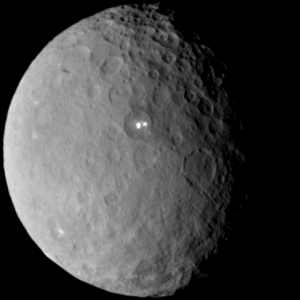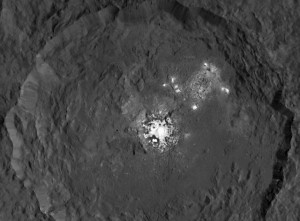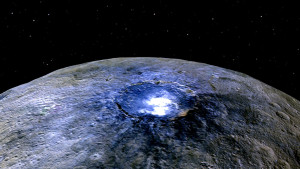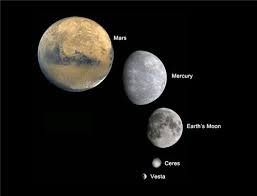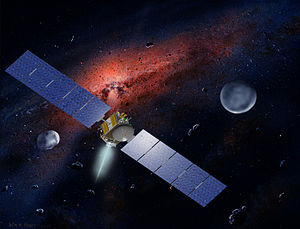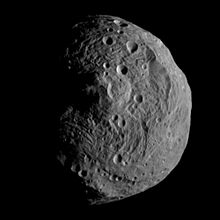Peter Lobner
In my 20 March 2015 post, I discussed the Dawn spacecraft mission to the large asteroid Vesta and the dwarf planet Ceres, both of which are in the main asteroid belt between Mars and Jupiter. Dawn arrived in orbit around Ceres on 6 March 2015, at an initial altitude of 8,400 miles (13,518 kilometers). On approach and from this high altitude orbit, Dawn photographed two very bright spots on the surface of Ceres.
After spending six months mapping the surface of Ceres and gradually descending to lower altitude orbits, Dawn currently is in a much lower “high-altitude mapping orbit” (HAMO) at 915 miles (1,470 kilometers) above the surface. Ceres’ diameter is about 587 miles (946 kilometers). Due to the low mass of this dwarf planet, Dawn’s orbital speed in the HAMO is only 400 mph (645 kph). The spacecraft completes one orbit in about 19 hours.
From its current vantage point in HAMO, Dawn has provided a much better view of the bright spots on Ceres. The following composite photo shows the bright spots at a resolution of 450 feet (140 meters) per pixel.
The source of the bright spots has not yet been determined. We’ll get a more detailed view later in 2015, when the spacecraft descends to the “low altitude mapping orbit” (LAMO) at an altitude of 230 miles (370 kilometers).
You can keep up with the work of the Dawn project team at the following NASA / Jet Propulsion Lab website:
9 December 2015 Update:
NASA’s Jet Propulsion Laboratory (JPL) released closeup photos of the bright spots, which appear to be globally distributed on Ceres. JPL scientists reported that Ceres has more than 130 bright areas, and most of them appear to be associated with impact craters. There is evidence that the bright spots may be salt deposits left behind after a subterranean briny water-ice deposit was exposed by an impact and the ice-water sublimated into space. Here is a closeup, false-color photo of the Occator Crater, emphasizing the deposits of bright material on the crater floor.
You can read more on this subject on the JPL website at the following link:
http://www.jpl.nasa.gov/news/news.php?feature=4785
1 November 2018 Update:
On 1 November 2018, NASA reported the end of the Dawn mission:
“Dawn missed scheduled communications sessions with NASA’s Deep Space Network on Wednesday, Oct. 31, and Thursday, Nov. 1. After the flight team eliminated other possible causes for the missed communications, mission managers concluded that the spacecraft finally ran out of hydrazine, the fuel that enables the spacecraft to control its pointing. Dawn can no longer keep its antennae trained on Earth to communicate with mission control or turn its solar panels to the Sun to recharge.”
You’ll find more information about the Dawn mission and its many accomplishments on the NASA / JPL website at the following link:
